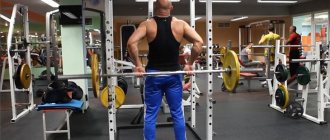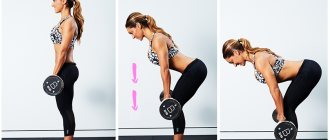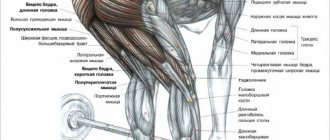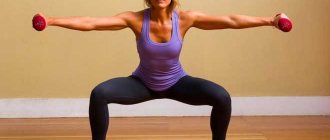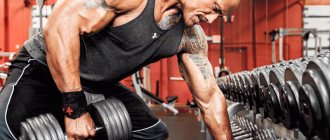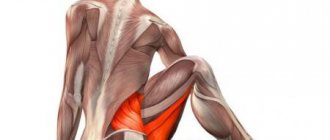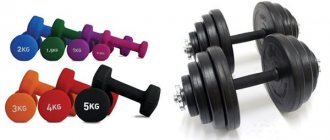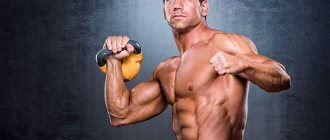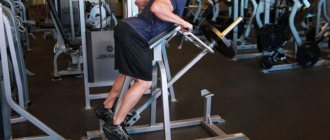The Romanian deadlift or Romanian barbell deadlift is a challenging but very effective strength exercise that helps develop your back muscles, hamstrings, and glutes.
If you have been working out in the gym for a long time and want to move on to serious strength training, then be sure to pay attention to this exercise. However, you should be extremely careful.
The Romanian deadlift with a barbell is a rather traumatic exercise, so you should pay as much attention as possible to the correct execution and safety precautions. And under no circumstances ignore safety rules.
We'll tell you everything now.
What you need to know about the Romanian deadlift?
Very often, athletes and beginners confuse the classic and Romanian deadlift with a barbell. At first, of course, it may seem that these are the same exercises - both involve a barbell.
However, the classic deadlift involves movements from the bottom up. In it, the pelvis needs to be lowered straight to the floor, and the Romanian deadlift moves from top to bottom and without the floor. Everything happens on extremely even legs. We lower the barbell exclusively to the middle of the shin.
During the Romanian deadlift, everything happens thanks to the alternation of active and static action. And, of course, the Romanian deadlift has its own variations.
Interesting Facts
Follow the correct technique, do not chase heavy working weights
The Romanian deadlift became known to the general public relatively recently. In 1990, an athlete from Romania, Niculae Vlad, was training in San Francisco.
When working the muscles of the back and legs, the athlete used a modified deadlift, in which the knees did not bend, and the bar was brought only to the upper third of the shin.
Although the exercise was not invented by Vlad Niculae himself and was not the development of his coaches, it became associated with Romanian weightlifters, which gave this type of deadlift its name.
The deadlift can be used to assess an athlete's strength - one way or another it involves all muscle groups. But in powerlifting competitions, the deadlift is used instead: it allows you to lift more weight, and is less likely to cause injury.
The leg muscles make up approximately half of the muscle mass. They need to pay a lot of attention during training. On the one hand, this will make the body proportional, on the other hand, it will contribute to the growth of the muscles of the upper body.
At the same time, many people forget about the back of the thighs and buttocks, focusing on the calves and quadriceps, but in fact, the hamstrings and gluteal muscles need to be given enough time.
No other exercise has such an effect on the development of these muscles as the deadlift.
Types of Romanian deadlifts
- Dumbbell deadlifts - the principle of action is the same as the Romanian barbell deadlift. However, deadlifts with dumbbells are considered the most traumatic and not as effective. It's all about the uneven distribution of weight and load on the spine.
- Romanian deadlift on one leg - everything is clear from the name. This type of deadlift is performed in a position where only one leg is the support leg. You take the dumbbell in one hand and lean on the other. At the same time, the body leans forward parallel to the floor. You stay in this position for a second and slowly return to the starting position.
- Romanian deadlift on straight legs - it has perfectly straight legs, no bending in the knees during execution. In other nuances it is no different from the usual Romanian deadlift.
- The Romanian Barbell Deadlift is a challenging exercise that targets every joint in your body. This involves the biceps dorsi, back extensors, gluteal muscles and the entire lumbar region.
Pros and cons of the exercise
PROS.
The Romanian dumbbell is good because it allows you to move more naturally, or, more precisely, more anatomically. This is possible due to the absence of a bar and the convenient location of the dumbbells on the side. The lower back is not overstrained, you are not constrained.
You can also do it at home. Not everyone has a barbell, but dumbbells are welcome.
The effectiveness of this exercise for working the hamstrings has been proven by a 2020 study published in the Journal of Strength and Conditioning Research.
Electromyography data showed very high activity of muscle activation, mainly of the long head.
Some people claim that this is almost the coolest exercise for the back of the thigh. Don’t rush to believe it until you feel it in practice. Personally, I am very skeptical about these kinds of statements until I personally check it in the room. “Dead” lift suits me better. By the way, I’ll have to write about her sometime.
Other benefits include increased flexibility in the hip joints, posture correction, the ability to perfectly strengthen the lower back and establish a balance between the quadriceps and hamstrings. For women - highlight the buttocks clearly.
MINUSES.
In my opinion, this is the problem of gaining the required weight of equipment (if we are talking about training at home). For this reason, this exercise is more popular among women. To be honest, I have never seen a seriously training guy do a deadlift with dumbbells.
It is also more difficult to move correctly, because dumbbells in the region of 30 kg already greatly interfere with this. With a barbell, even a heavier one, it is much easier to perform movements exactly, strictly along the trajectory.
What muscles work during the Romanian deadlift?
Agree, this is the main question that interests everyone who decides to resort to such a dangerous and difficult exercise as the Romanian deadlift.
Let's figure out which muscles are involved and why we still need the Romanian deadlift with dumbbells or a barbell.
The main load during the Romanian deadlift goes to the lumbar muscles, to the entire posterior thigh muscle group. The trapezius muscles, gluteus maximus and quadriceps of your thigh also take part.
Additional (albeit less, but still) load is placed on the tibialis anterior, gluteus medius and gluteus minimus muscles. The deltoid and adductor muscles of the thigh are also involved.
As you can see, this exercise pumps up all sorts of muscles in your thighs, which allows you to create a butt better than Kim’s.
Inclusion in the program
Placement in the program depends on the level of the athlete. If he can lift a heavy enough weight with this version of the Romanian deadlift, he will be able to use this exercise as a foundation exercise. It can be the first in training the hamstrings and provide enough load. Then the training is supplemented with lunges, step-ups and glute bridges.
But most often it turns out that this exercise is performed in the second part of the workout, after the classic deadlift or sumo deadlift, because the athlete is simply not comfortable doing this movement with a large weight. This is a completely valid approach and can be used as an option for a comprehensive leg workout.
When planning your load, you should adhere to the rule of 12 working approaches if we are talking about fitness and not professional sports. Thus, if you are performing classic or sumo deadlifts, doing a “Romanian” with dumbbells in more than 3 approaches is not advisable, since the third exercise is usually an isolating exercise for the hamstrings.
The breakdown of the number of repetitions depends more on the pace and goal of the athlete, and not on his gender. It is often said that women's muscles are special and respond better to 12-15 repetitions. This is not so; for mass gain and a slow pace of movement, 6-10 repetitions are more justified.
Basic rules for performing the Romanian deadlift
As we have already said, this is a more difficult and quite dangerous exercise. Therefore, before starting it, it is worth studying the technique and rules.
This is necessary for the exercise to be effective and safe for you.
So, the direction of movement goes from top to bottom. It is best to lift the barbell from the floor and place it on a special barbell rack, which is located at the level of your pelvis.
You definitely need shoes with flat and wide soles that fit snugly on your feet and don’t slip. Otherwise, you may lose stable support and injure your lower back.
We take the barbell with a classic straight grip in the middle, at a distance wider than the shoulders.
When you begin to lower the bar, make sure that it runs closely along your legs. This is how the necessary load will be on the lower back muscles, and not on the spine.
Execution technique
- Take a pair of dumbbells (one in each hand) and place them at the sides of your body in front of you. Hold with an overhand grip (palms facing your feet). It is important that the torso is vertical, the arms are straight, and the shoulder blades are brought together and lowered down. This increases tension in the back and prevents unwanted rounding of the shoulders forward.
- Place your feet shoulder-width apart and bend your knees slightly to ensure a smooth descent of the weight. Make sure the dumbbells move (slide) vertically near the front of your thighs (don't let them move forward). To do this, move your pelvis back, but keep your back straight and your knees in line with your ankles. As a result, you will feel tension in the back of your thighs (biceps) and throughout your back (bottom and middle, and especially around the shoulder blades). Lower yourself down just below your knees until you feel a distinct stretch in your hamstrings. Pause at the bottom point for 1-2 seconds.
- After this, use your buttocks and thighs to push yourself upward. At the top of the movement, tighten your upper back, torso, and glutes.
- Inhale as you go down, and exhale as you go up.
- Complete the required number of repetitions.
We include it in our training
Introducing a simple and effective lower body workout program that includes the Romanian deadlift. Before any workout, remember to thoroughly warm up your muscles. You can modify it according to your preferences:
| Squats | 3 sets of 4-6 reps (80-85% of maximum weight) |
| Romanian deadlift | 3 sets of 4-6 reps (80-85% of maximum weight) |
| Single leg squats or lunges | 3 sets of 6-8 reps (75-80% of maximum weight) |
| Lying leg curls | 2 sets of 6-8 reps (75-80% of maximum weight) |
| Additional exercise: standing calf raises | 2 sets of 8-12 reps (70-80% of maximum weight) |
Runtime errors
1. One of the most common mistakes is performing the exercise with a rounded back. Basically, this error occurs when there is excessive weight on the projectile. The body is not able to lift the barbell using the correct technique, and the back comes in to help, which makes it a c-shaped bend. Always watch your back, it should be straight.
2. The bar is too far away. Too far a position is fraught with incorrect technique, since the projectile goes too far from the legs.
3. Bend your arm at the elbow. This happens when the weight of the projectile is too heavy. When an athlete tries with all his might to lift the barbell, it happens that the grip weakens, and you want to straighten the bar by bending your arms.
In addition to these three mistakes, I also recommend paying attention to:
- Shoes. It is recommended to wear sneakers that fit snugly to your feet so that you can feel the floor while performing the exercise.
- Different grips. Used when the projectile is too heavy.
You may experience a problem in the form of a weak grip when you deadlift with too much weight. To avoid this mistake, I recommend using straps.
Dear friends, I advise people who have back problems not to do such exercises. This can only make the situation worse. Before starting training, I recommend consulting a doctor and agreeing with him on all the exercises that can be performed without harming the body.
Now that we've covered the basic concepts and the most common mistakes that hinder quality execution, let's talk about technique.
Is deadlift suitable for everyone?
In order to achieve the planned result, the execution technique must be impeccable. This requires a mobile hip joint and good stretching of the back and hip muscles. How can I check this? – There are tests.
Try, without bending your knees or rounding your back, lean forward and touch the floor with your fingertips. If you succeed, run to the hall. If you couldn’t reach it, you need to develop stretching and only then start deadlifting.
What is this for? – So as not to load the spine. Its technically correct position in this exercise should be straight with a bend, but not rounded. Only then will it be firmly fixed and be able to handle large weights in the future without damage.
In any case, you can’t do without a warm-up. The body is always prepared for exercise. To avoid injury, it is strictly forbidden to exercise on cold muscles.
In addition to the main task, the deadlift performs related tasks. With less load, but still the muscles of the abs, forearm, and upper back are involved. Yes, the inner thighs are involved.
